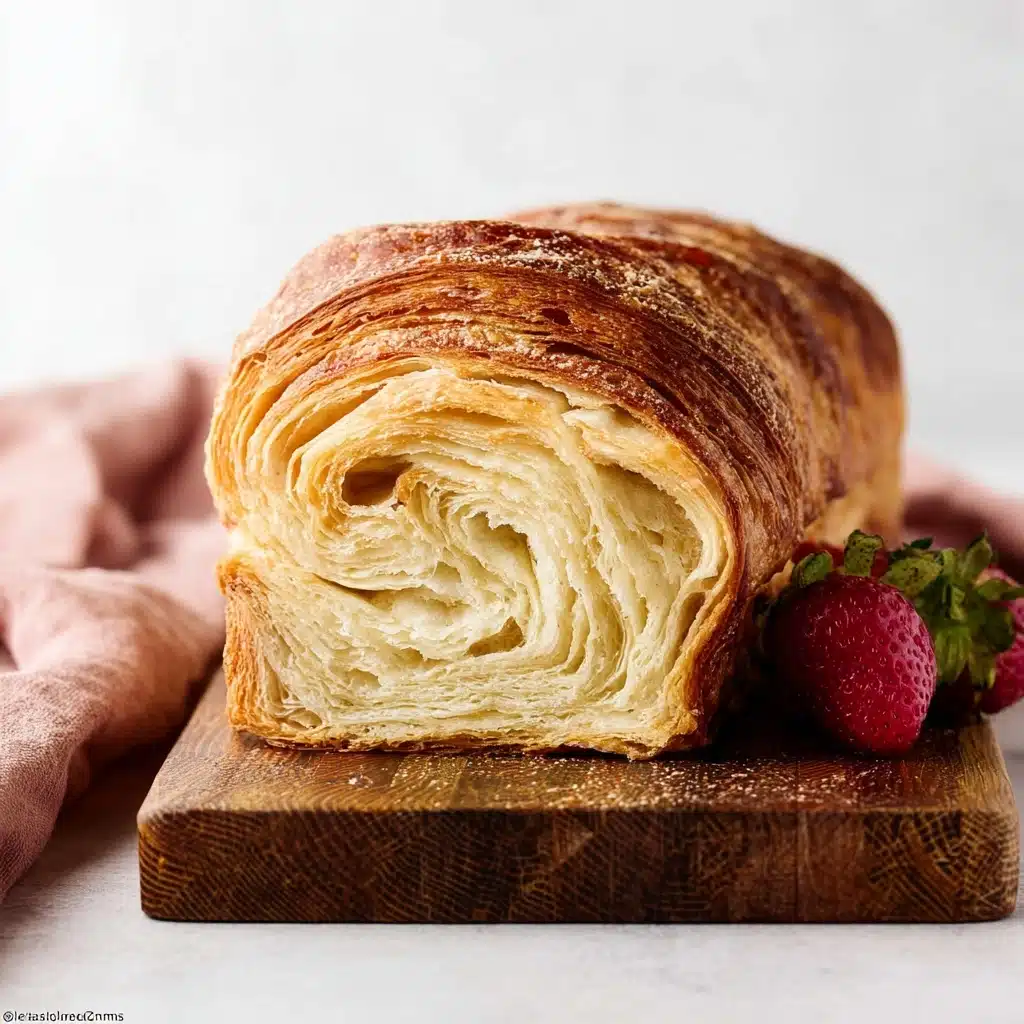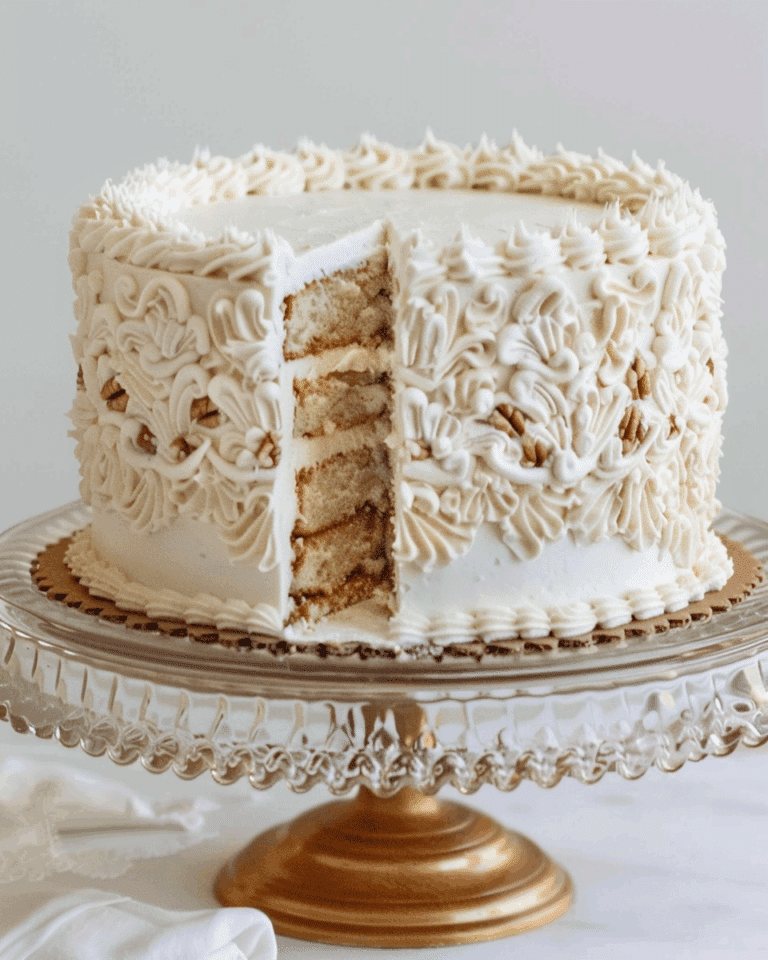There’s nothing quite like homemade Croissant Bread (Loaf)—a showstopper that combines the shattering flakiness of classic croissants with the irresistible comfort of fresh bread. Imagine buttery, golden layers rising high in your kitchen and filling the air with that heady, bakery-style aroma. Whether you’re a seasoned baker or trying something ambitious for a special brunch, this loaf is a guaranteed crowd-pleaser, with a tender crumb and deeply satisfying flavor that makes every slice feel like a true indulgence.

Ingredients You’ll Need
The magic of Croissant Bread (Loaf) starts with a straightforward list of kitchen staples. Each ingredient plays an unmistakable role: from forming the soft dough to creating that signature buttery flakiness and rich golden hue. Gather the freshest you can find—a loaf this good deserves it!
- Whole milk (1 cup, 240ml): This gives the dough a soft, slightly sweet richness that’s the foundation of every good loaf.
- Instant or active dry yeast (2 and 1/4 tsp, 7g): The leavening power here is what gives your croissant bread its beautiful rise and airy crumb.
- Granulated sugar (3 Tbsp, 38g): Provides the dough with subtle sweetness; the sugar also feeds your yeast.
- Salt (1 and 1/4 tsp): Balances flavors and strengthens the delicate dough structure.
- Butter, softened (3 Tbsp, 43g): Adds luxurious tenderness right from the start—don’t skip this for an even, rich crumb.
- All-purpose flour (3 cups, 375g): Reliable and easily accessible, this is what builds structure and shape for our loaf’s perfect rise.
- More flour (for dusting): Essential for kneading and rolling, so your dough doesn’t get sticky during those all-important folds.
- Salted butter for lamination (3/4 cup, 170g): Slightly softened, this is the secret to decadent layers—choose high-quality butter if you can.
- Large egg (1): Used in the egg wash, this creates that famous golden, shiny croissant crust.
- Water for egg wash (1 Tbsp, 15ml): Loosens the egg just enough for smooth, even brushing.
How to Make Croissant Bread (Loaf)
Step 1: Activate the Yeast
Start by whisking together the warm milk, yeast, and granulated sugar in your stand mixer bowl. After a quick five-minute rest, you’ll notice a layer of delicate foam—this is your yeast springing to life and promising a lofty, airy loaf.
Step 2: Mix the Dough
With your yeast now ready, add the salt, softened butter, and two cups of the flour. Beat on medium, pausing to scrape down the sides as needed. Add the remaining flour, and keep mixing just until everything comes together. Your goal is a soft, supple dough that’s not too sticky—add a touch more flour if necessary, but don’t overdo it.
Step 3: Knead Until Smooth
Let your mixer do the work for five more minutes, or turn your dough out and knead by hand. You’ll be rewarded with a gently springy dough—one that bounces back when poked. If you want to check your progress, try the windowpane test: stretch a little piece of dough and see if it turns delightfully translucent before breaking.
Step 4: The First Rise
Transfer your dough to a greased bowl, turning it so every inch is lightly coated. Cover and let it rise in a warm spot for 1.5 to 2 hours. Don’t rush this part—it’s where your croissant bread (loaf) starts developing its signature lift and softness.
Step 5: Shape and Chill
Punch down the dough to release excess air, then stretch it gently into a 10 by 14-inch rectangle on a baking mat or lightly floured parchment. Loosely cover and refrigerate for 20 minutes—this rest makes the dough easier to handle during the next, buttery step.
Step 6: Prepare for Lamination
Get your salted butter ready by cutting it into thin, even slices (about 1/4 inch thick). Make sure it’s firm but pliable—this ensures perfect layering. While the dough chills, relax and gather your patience; lamination is part art, part science, and totally worth it.
Step 7: First Lamination
Place the chilled dough in front of you. Neatly arrange your butter slices over the center third, then fold the dough like a business letter, pinching the edges to seal the buttery goodness inside. Roll it out into a 9 by 12-inch rectangle, refold, cover, and chill again. Every fold is building magical layers!
Step 8: Second and Third Laminations
Repeat the rolling and folding steps twice, refrigerating briefly between each round. Don’t stress if the dough resists or butter peeks out—a sprinkle of flour can easily patch things up. Each lamination deepens the flavor and ensures that epic croissant texture.
Step 9: Final Lamination and Shaping
Unfold your dough for one last roll and fold sequence. Then, from the short side, carefully roll into a tight 9-inch log, jelly-roll style. Slice into five equal pieces—no need for perfection here!—and place them, seam side down, in a greased 9×5 inch loaf pan.
Step 10: Second Rise and Bake
Cover the filled pan and let the rolls puff up for 45 to 60 minutes until they look delightfully pillowy. Preheat your oven to 350°F (177°C), whisk up your egg wash, and brush it generously over the top. Bake for one hour, tenting with foil after 25 minutes if needed. The top should be deeply golden and irresistible—a sign that you’re almost there!
Step 11: Cool and Slice
Give your Croissant Bread (Loaf) some time to cool in the pan (30 minutes), then gently turn it out onto a rack for at least 15 more minutes. While it’s tempting to cut into it immediately, patience rewards you with neat, beautiful slices instead of squashed, melty layers.
How to Serve Croissant Bread (Loaf)

Garnishes
For a stunning finish, brush your croissant bread (loaf) slices with a touch of melted butter and a sprinkle of flaky salt. A dusting of powdered sugar or a swipe of jam transforms each slice into a bakery-worthy treat that will wow your brunch guests.
Side Dishes
This rich, buttery bread pairs beautifully with everything from fresh fruit salad to softly scrambled eggs. For a cozy breakfast, serve it alongside creamy Greek yogurt and berries, or offer thin slices with a steaming bowl of tomato soup for an unexpected, luxurious lunch.
Creative Ways to Present
Put a twist on tradition by turning slices of Croissant Bread (Loaf) into decadent French toast or gourmet grilled cheese. You can also cube it for a savory bread pudding or serve toasted with a drizzle of honeycomb for an unforgettable dessert board centerpiece.
Make Ahead and Storage
Storing Leftovers
Keep leftover Croissant Bread (Loaf) soft and fresh by wrapping it tightly or storing in an airtight container at room temperature for up to three days. If your kitchen is warm or humid, pop it in the fridge where it’ll keep for about a week.
Freezing
To savor every last buttery crumb, freeze sliced or unsliced bread wrapped well in plastic, then foil, for up to three months. Thaw overnight in the fridge or at room temperature. The flavors mature beautifully, making every reheated slice a real treat.
Reheating
For best results, gently rewarm slices in a toaster oven or regular oven at 300°F (150°C) for five to seven minutes. You can also pop a slice in your toaster (just keep an eye on it!). This brings back that fresh-from-the-oven crispiness and aroma.
FAQs
Can I make croissant bread (loaf) without a stand mixer?
Absolutely! Mixing and kneading entirely by hand with a sturdy wooden spoon and some elbow grease works beautifully. The dough might be sticky, so keep your hands and work surface lightly floured. The process is almost meditative—give it a try!
Why did my butter leak out during lamination?
A little butter seepage is totally natural. If it’s excessive, your butter may have been too soft or your dough got too warm. Try working quickly and chilling your dough and butter as needed. If butter escapes, just sprinkle it with a touch of flour and keep folding.
Can I use unsalted butter for lamination?
You sure can! Just add a pinch of extra salt to your dough to compensate. Salted butter adds flavor, but unsalted gives you full control over saltiness—either works for croissant bread (loaf).
How do I know when my loaf is fully baked?
Look for a deep golden-brown top and a hollow sound when you tap the crust. If you’re unsure, an instant-read thermometer inserted into the center should read about 195°F (90°C). This ensures a perfectly baked, not doughy, center every time.
Is croissant bread (loaf) good for sandwiches?
Oh yes! The flaky, buttery texture is out-of-this-world with everything from chicken salad to ham and Swiss. Sliced thick or thin, this loaf elevates even the simplest sandwich into something special.
Final Thoughts
Baking Croissant Bread (Loaf) at home is more than just a recipe—it’s an experience worth savoring. Once you’ve tried that first melt-in-your-mouth bite, you’ll be hooked! Invite friends, make it your own, and let the layers of flavor and joy shine at your table.
Print
Croissant Bread (Loaf) Recipe
- Prep Time: 4 hours, 45 minutes
- Cook Time: 1 hour
- Total Time: 6 hours, 30 minutes (includes cooling)
- Yield: 1 loaf
- Category: Bread
- Method: Baking
- Cuisine: French-inspired
- Diet: Vegetarian
Description
This Croissant Bread Loaf recipe delivers all the flaky, buttery layers of classic croissants in the simplicity of a homemade loaf. With a rich dough, meticulous lamination, and a stunning golden crust, this bread is perfect for breakfast, brunch, or as an indulgent snack. Each slice boasts irresistible layers, making it an impressive treat for bakers looking to master laminated dough at home.
Ingredients
Dough
- 1 cup (240ml) whole milk, warmed to about 110°F (43°C)
- 2 and 1/4 teaspoons (7g) instant or active dry yeast (1 standard packet)
- 3 tablespoons (38g) granulated sugar
- 1 and 1/4 teaspoons salt
- 3 tablespoons (43g) unsalted or salted butter, softened to room temperature and cut into 3 equal pieces
- 3 cups (375g) all-purpose flour (spooned & leveled), plus more as needed and for lamination
Lamination
- 3/4 cup (12 Tbsp; 170g) salted butter, slightly softened
Egg Wash
- 1 large egg, cold or room temperature
- 1 tablespoon (15ml) water
Instructions
- Prepare the Dough Base: In the bowl of your stand mixer fitted with a dough hook, whisk together the warm milk, yeast, and sugar. Cover and let it sit for about 5 minutes until foamy. If you don’t have a mixer, use a large bowl and mix by hand with a wooden spoon or silicone spatula.
- Add Main Dough Ingredients: Add the salt, softened butter, and 2 cups (250g) of the flour. Beat on medium speed for 2 minutes, scraping the bowl as needed. Add the remaining flour and beat on low speed until a soft, slightly tacky dough forms, pulling away from the bowl’s sides. If the dough is overly sticky, mix in an extra 2–3 tablespoons of flour, but do not overdo it.
- Knead the Dough: Continue beating in the mixer for 5 minutes more, or knead by hand on a lightly floured surface for 5 minutes. If the dough gets too sticky, sprinkle with 1 teaspoon of flour at a time until it’s workable—but keep the dough soft. Test by poking—if it bounces back slowly or passes the windowpane test, it’s ready.
- First Rise: Lightly grease a large bowl and place the dough inside, turning to coat it. Cover with foil, plastic wrap, or a towel, and allow to rise in a warm spot for 1.5–2 hours, or until nearly doubled in size.
- Flatten and Chill Dough: Punch down to release air. Move dough to a lined or lightly floured baking sheet, and gently shape into a 10×14-inch (25x35cm) rectangle. Lightly cover and refrigerate for 20 minutes to rest the gluten and chill the butter.
- Prepare for Lamination: While the dough chills, cut the salted butter for lamination into 1/4-inch slices. Ensure the butter is pliable but not too soft—this is key for proper layering.
- First Lamination: Remove dough from the fridge. With the long side facing you, arrange butter slices down the center third. Fold both edges over the butter like a business letter and seal short ends to keep butter inside. Rotate dough, roll out to 9×12-inch (23x30cm) rectangle, then fold again like a business letter. Cover and refrigerate for 20 minutes.
- Second & Third Laminations: Repeat the process: rotate dough, roll out to 9×12-inch rectangle, fold like a letter, rotate and repeat one more time. Cover and refrigerate for another 20 minutes. Do not over-chill.
- Final Lamination & Shaping: One last time, roll out to a 9×12-inch rectangle, fold into thirds, then roll out again to the same size. Roll up tightly from one 9-inch edge to form a log. Cut the log into 5 even rolls.
- Second Rise: Grease a 9×5-inch loaf pan, arrange the rolls seam side down inside, cover tightly, and let rise in a warm spot for 45–60 minutes, until slightly puffy.
- Egg Wash & Bake: Preheat oven to 350°F (177°C). Whisk egg and water. Brush the top of the risen loaf generously with egg wash. Bake for 1 hour—tent with foil after 25 minutes so the crust doesn’t over-brown. For doneness, the loaf’s center should reach 195°F (90°C) internally.
- Cool & Serve: Place baked loaf (in the pan) on a wire rack and cool for 30 minutes. Loosen the loaf with a knife, remove from pan, and cool at least 15 minutes more before slicing. Bread is best when completely cooled, as warm slices may fall apart.
Notes
- If using active dry yeast, ensure milk is not hotter than 110°F (43°C), or you may kill the yeast.
- Use a silicone baking mat for easier rolling and transfer; parchment or a lightly floured surface works in a pinch.
- If any butter leaks or is exposed during rolling, simply sprinkle with flour and continue—it won’t affect the final result.
- Don’t rush or extend refrigeration times—timing is important for flaky layers and proper gluten relaxation.
- Bread keeps covered at room temperature for 3 days, or refrigerated for up to 1 week. Freeze for up to 3 months, then thaw & reheat as needed.
- Let bread cool completely before slicing for the best texture and layers.
Nutrition
- Serving Size: 1 slice (1/12 loaf, approx. 65g)
- Calories: 290
- Sugar: 4g
- Sodium: 310mg
- Fat: 15g
- Saturated Fat: 9g
- Unsaturated Fat: 5g
- Trans Fat: 0g
- Carbohydrates: 33g
- Fiber: 1g
- Protein: 6g
- Cholesterol: 60mg







